+ Open data
Open data
- Basic information
Basic information
| Entry | Database: PDB / ID: 3gxu | ||||||
|---|---|---|---|---|---|---|---|
| Title | Crystal structure of Eph receptor and ephrin complex | ||||||
 Components Components |
| ||||||
 Keywords Keywords | TRANSFERASE / Complex structure / Eph / ephrin / ATP-binding / Glycoprotein / Kinase / Membrane / Nucleotide-binding / Phosphoprotein / Receptor / Transmembrane / Tyrosine-protein kinase / Developmental protein / Differentiation / Disulfide bond / Host-virus interaction / Neurogenesis | ||||||
| Function / homology |  Function and homology information Function and homology informationDH domain binding / neuron projection fasciculation / : / negative regulation of proteolysis involved in protein catabolic process / corticospinal tract morphogenesis / regulation of astrocyte differentiation / neuron projection guidance / venous blood vessel morphogenesis / nephric duct morphogenesis / fasciculation of sensory neuron axon ...DH domain binding / neuron projection fasciculation / : / negative regulation of proteolysis involved in protein catabolic process / corticospinal tract morphogenesis / regulation of astrocyte differentiation / neuron projection guidance / venous blood vessel morphogenesis / nephric duct morphogenesis / fasciculation of sensory neuron axon / fasciculation of motor neuron axon / positive regulation of aorta morphogenesis / synapse pruning / negative regulation of cellular response to hypoxia / negative regulation of axon regeneration / positive regulation of cardiac muscle cell differentiation / transmembrane-ephrin receptor activity / glial cell migration / positive regulation of amyloid precursor protein catabolic process / presynapse assembly / PH domain binding / regulation of modification of synaptic structure / GPI-linked ephrin receptor activity / regulation of synapse pruning / lymph vessel development / regulation of chemotaxis / adherens junction organization / positive regulation of dendrite morphogenesis / regulation of dendritic spine morphogenesis / negative regulation of cell adhesion / motor neuron axon guidance / cell migration involved in sprouting angiogenesis / EPH-Ephrin signaling / blood vessel morphogenesis / innervation / Ephrin signaling / adult walking behavior / regulation of GTPase activity / negative regulation of epithelial to mesenchymal transition / Somitogenesis / regulation of axonogenesis / positive regulation of amyloid-beta formation / EPHA-mediated growth cone collapse / regulation of postsynaptic neurotransmitter receptor internalization / positive regulation of intracellular signal transduction / negative regulation of long-term synaptic potentiation / cochlea development / keratinocyte proliferation / EPH-ephrin mediated repulsion of cells / anatomical structure morphogenesis / negative regulation of keratinocyte proliferation / ephrin receptor signaling pathway / axonal growth cone / regulation of postsynaptic membrane neurotransmitter receptor levels / ephrin receptor binding / T cell costimulation / axon terminus / EPHB-mediated forward signaling / positive regulation of cell adhesion / axon guidance / protein tyrosine kinase binding / peptidyl-tyrosine phosphorylation / negative regulation of cell migration / animal organ morphogenesis / dendritic shaft / positive regulation of JNK cascade / adherens junction / filopodium / neuromuscular junction / receptor protein-tyrosine kinase / postsynaptic density membrane / negative regulation of ERK1 and ERK2 cascade / Schaffer collateral - CA1 synapse / cellular response to amyloid-beta / kinase activity / cell-cell signaling / negative regulation of neuron projection development / amyloid-beta binding / protein autophosphorylation / cellular response to lipopolysaccharide / presynaptic membrane / virus receptor activity / protein tyrosine kinase activity / early endosome membrane / perikaryon / dendritic spine / negative regulation of neuron apoptotic process / mitochondrial outer membrane / protein kinase activity / cell adhesion / negative regulation of translation / protein stabilization / positive regulation of cell migration / axon / focal adhesion / positive regulation of cell population proliferation / dendrite / glutamatergic synapse / cell surface / ATP binding Similarity search - Function | ||||||
| Biological species |  Homo sapiens (human) Homo sapiens (human) | ||||||
| Method |  X-RAY DIFFRACTION / X-RAY DIFFRACTION /  MOLECULAR REPLACEMENT / Resolution: 2.5 Å MOLECULAR REPLACEMENT / Resolution: 2.5 Å | ||||||
 Authors Authors | Qin, H.N. / Song, J.X. | ||||||
 Citation Citation |  Journal: J.Biol.Chem. / Year: 2009 Journal: J.Biol.Chem. / Year: 2009Title: Structural characterization of the EphA4-ephrin-B2 complex reveals new features enabling Eph-ephrin binding promiscuity Authors: Qin, H. / Noberini, R. / Huan, X. / Shi, J. / Pasquale, E.B. / Song, J. #1:  Journal: J.Biol.Chem. / Year: 2008 Journal: J.Biol.Chem. / Year: 2008Title: Crystal structure and NMR binding reveal that two small molecule antagonists target the high affinity ephrin-binding channel of the EphA4 receptor Authors: Qin, H. / Shi, J. / Noberini, R. / Pasquale, E.B. / Song, J. #2:  Journal: Nature / Year: 2001 Journal: Nature / Year: 2001Title: Crystal structure of an Eph receptor-ephrin complex Authors: Himanen, J.P. / Rajashankar, K.R. / Lackmann, M. / Cowan, C.A. / Henkemeyer, M. / Nikolov, D.B. | ||||||
| History |
|
- Structure visualization
Structure visualization
| Structure viewer | Molecule:  Molmil Molmil Jmol/JSmol Jmol/JSmol |
|---|
- Downloads & links
Downloads & links
- Download
Download
| PDBx/mmCIF format |  3gxu.cif.gz 3gxu.cif.gz | 83 KB | Display |  PDBx/mmCIF format PDBx/mmCIF format |
|---|---|---|---|---|
| PDB format |  pdb3gxu.ent.gz pdb3gxu.ent.gz | 61.7 KB | Display |  PDB format PDB format |
| PDBx/mmJSON format |  3gxu.json.gz 3gxu.json.gz | Tree view |  PDBx/mmJSON format PDBx/mmJSON format | |
| Others |  Other downloads Other downloads |
-Validation report
| Summary document |  3gxu_validation.pdf.gz 3gxu_validation.pdf.gz | 408.9 KB | Display |  wwPDB validaton report wwPDB validaton report |
|---|---|---|---|---|
| Full document |  3gxu_full_validation.pdf.gz 3gxu_full_validation.pdf.gz | 429.2 KB | Display | |
| Data in XML |  3gxu_validation.xml.gz 3gxu_validation.xml.gz | 11.5 KB | Display | |
| Data in CIF |  3gxu_validation.cif.gz 3gxu_validation.cif.gz | 17.4 KB | Display | |
| Arichive directory |  https://data.pdbj.org/pub/pdb/validation_reports/gx/3gxu https://data.pdbj.org/pub/pdb/validation_reports/gx/3gxu ftp://data.pdbj.org/pub/pdb/validation_reports/gx/3gxu ftp://data.pdbj.org/pub/pdb/validation_reports/gx/3gxu | HTTPS FTP |
-Related structure data
- Links
Links
- Assembly
Assembly
| Deposited unit | 
| ||||||||
|---|---|---|---|---|---|---|---|---|---|
| 1 |
| ||||||||
| Unit cell |
|
- Components
Components
| #1: Protein | Mass: 20206.844 Da / Num. of mol.: 1 / Fragment: UNP residues 29-203 Source method: isolated from a genetically manipulated source Source: (gene. exp.)  Homo sapiens (human) / Gene: EPHA4, HEK8, SEK, TYRO1 / Plasmid: PET32a / Production host: Homo sapiens (human) / Gene: EPHA4, HEK8, SEK, TYRO1 / Plasmid: PET32a / Production host:  References: UniProt: P54764, receptor protein-tyrosine kinase |
|---|---|
| #2: Protein | Mass: 16261.525 Da / Num. of mol.: 1 / Fragment: UNP residues 27-169 Source method: isolated from a genetically manipulated source Source: (gene. exp.)  Homo sapiens (human) / Gene: EFNB2, EPLG5, HTKL, LERK5 / Plasmid: PET32a / Production host: Homo sapiens (human) / Gene: EFNB2, EPLG5, HTKL, LERK5 / Plasmid: PET32a / Production host:  |
| #3: Water | ChemComp-HOH / |
| Has protein modification | Y |
-Experimental details
-Experiment
| Experiment | Method:  X-RAY DIFFRACTION / Number of used crystals: 1 X-RAY DIFFRACTION / Number of used crystals: 1 |
|---|
- Sample preparation
Sample preparation
| Crystal | Density Matthews: 2.21 Å3/Da / Density % sol: 44.22 % |
|---|---|
| Crystal grow | Temperature: 298 K / Method: vapor diffusion, hanging drop / pH: 7.5 Details: 23.5% PEG4000, 0.1M Tris, 0.2M MgCl2, pH7.5, VAPOR DIFFUSION, HANGING DROP, temperature 298K |
-Data collection
| Diffraction | Mean temperature: 100 K |
|---|---|
| Diffraction source | Source:  ROTATING ANODE / Type: BRUKER AXS MICROSTAR-H ROTATING ANODE / Type: BRUKER AXS MICROSTAR-H |
| Radiation | Protocol: SINGLE WAVELENGTH / Monochromatic (M) / Laue (L): M / Scattering type: x-ray |
| Radiation wavelength | Relative weight: 1 |
| Reflection | Resolution: 2.5→50 Å / Num. all: 11071 / Num. obs: 10938 |
- Processing
Processing
| Software |
| ||||||||||||||||||||
|---|---|---|---|---|---|---|---|---|---|---|---|---|---|---|---|---|---|---|---|---|---|
| Refinement | Method to determine structure:  MOLECULAR REPLACEMENT MOLECULAR REPLACEMENTStarting model: PDB ENTRY 3CKH, 1KGY Resolution: 2.5→25 Å / σ(F): 3 / σ(I): 3 / Stereochemistry target values: Engh & Huber
| ||||||||||||||||||||
| Refinement step | Cycle: LAST / Resolution: 2.5→25 Å
|
 Movie
Movie Controller
Controller





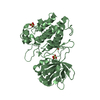

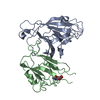
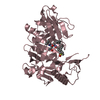
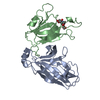

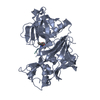


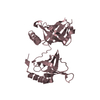
 PDBj
PDBj









